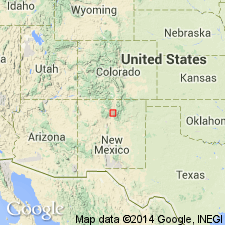
- Usage in publication:
-
- Pojoaque Member
- Modifications:
-
- Named
- Dominant lithology:
-
- Sandstone
- Gravel
- Ash
- Tuff
- AAPG geologic province:
-
- Estancia basin
- San Juan basin
Summary:
Named as third from top of five members of Tesuque Formation (revised) of Santa Fe Group (ascending): Nambe, Skull Ridge, Pojoaque, Chama-El Rito, and Ojo Caliente Sandstone. Type area of Santa Fe Group is here restricted to north of Santa Fe, in the Rio Grande Valley (includes parts of northern Santa Fe Co (Estancia basin), southeastern Rio Arriba Co (San Juan basin), and southern Taos Co (San Luis basin). In this area, Santa Fe Group is divided into Chamita Formation (top) and Tesuque Formation, with its 5 members (base). Pojoaque consists of pink to buff or tan to gray granitic soft sandstones, with beds of granitic gravel. A few volcanic ash beds and tuff are also present. Valentinian and Clarendonian mammalian fossils numerous. Type section designated in SW 1/2 of SE 1/4 sec 36, T20N, R8E, Santa Fe Co, NM in Estancia basin. Pojoaque is the Spanish pronunciation of a Tewa Indian word meaning "drinking water place." Exposed in central Pojoaque Bluffs (Los Barrancos). In general, crops out in a semicircular belt of isolated groups of exposures from the vicinity of Chimayo, NM, north of Santa Cruz River, to Santa Cruz, through Espanola, San Ildefonso, Pojoaque, to general locality west of Tesuque Indian Pueblo, Rio Arriba Co, San Juan basin. Disconformably overlies Skull Ridge Member; interfingers with underlying Chama-El Rito Member in some places. Age given as late Barstovian through most of the Clarendonian. Geologic map. Sections.
Source: GNU records (USGS DDS-6; Denver GNULEX).
For more information, please contact Nancy Stamm, Geologic Names Committee Secretary.
Asterisk (*) indicates published by U.S. Geological Survey authors.
"No current usage" (†) implies that a name has been abandoned or has fallen into disuse. Former usage and, if known, replacement name given in parentheses ( ).
Slash (/) indicates name conflicts with nomenclatural guidelines (CSN, 1933; ACSN, 1961, 1970; NACSN, 1983, 2005, 2021). May be explained within brackets ([ ]).

